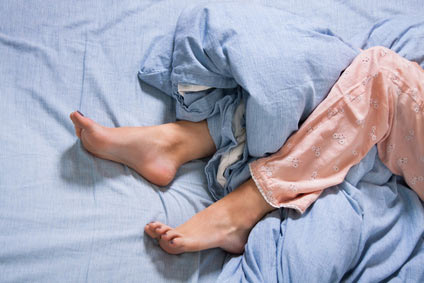Restless Leg Syndrome
How to Reduce, prevent, and Cope with Restless Leg Syndrome

In restless leg syndrome uncontrollable limb movements are a regular occurrence that can make it impossible to obtain a restful night’s sleep.
Restless leg syndrome (RLS) is a neurological disorder, and not a sleep disorder as others believe.
The problem with RLS is an almost irresistible urge to move the legs, due to unpleasant feelings.
These feelings appear most of the time when a person is sleeping or resting.
A key feature of RLS is that the unpleasant sensations are worse in the evening or night than during the day, or is occurring only in the night.
These sensations may even occur when sitting for a long period of time, such as while at a desk, watching a movie, or driving a car.
The following video explains more about RLS:
Side effects of Restless Leg Syndrome
The effect of RLS on sleep is a disturbing sleep onset, causing excessive daytime drowsiness.
Sleep apnea can worsen RLS due to sleep fragmentation. Also, the adherence to CPAP treatment is affected due to this restless sleep.
Causes of RLS
Unfortunately, the cause of RLS is unknown, but is suggested a genetic link.
Another cause may be related to low iron levels, or anemia, which results in a lack of dopamine. If you didn't know, dopamine is used by the brain to control limb movements.
Once iron levels are corrected with supplements and a better nutrition, patients may see that their restless leg symptoms will disappear.
Use of medications may cause RLS, such as metoclopramide or prochlordrperazie, antiseizure drugs like droperidol, or cold and allergy medications.
This video explains more about the risk factors of RLS:
How to Diagnose RLS?
In the following video you will learn how doctors can diagnose restless legs syndrome:
Treatments for RLS
The restless leg syndrome treatment will not cure the disorder, but the symptoms may disappear for a period of time and offer more restful nights.
The best improvements are seen when a patient is given dopamine, through a treatment. Like any other medication, there are side effects of dopaminergic therapy, such as nausea, vomiting, dizziness, muscle aches, headaches, constipation.
If you have a mild case of RLS, you can use alternative therapy, such as sedatives. Ropinirole is the only drug approved for the treatment of restless leg syndrome.
To reduce the symptoms of RLS, you can use behavioral strategies. This strategies include exercise, leg massage before bedtime, and warm baths.
Scientists suggest that sticking to a routine sleep schedule can reduce this symptoms. Decreased use of alcohol, tobacco and caffeine may provide relief for a patient with a mild RLS.
For more info about treatments for RLS, see restless leg syndrome treatment.
Sleep Apnea Guide › Restless Leg Syndrome







